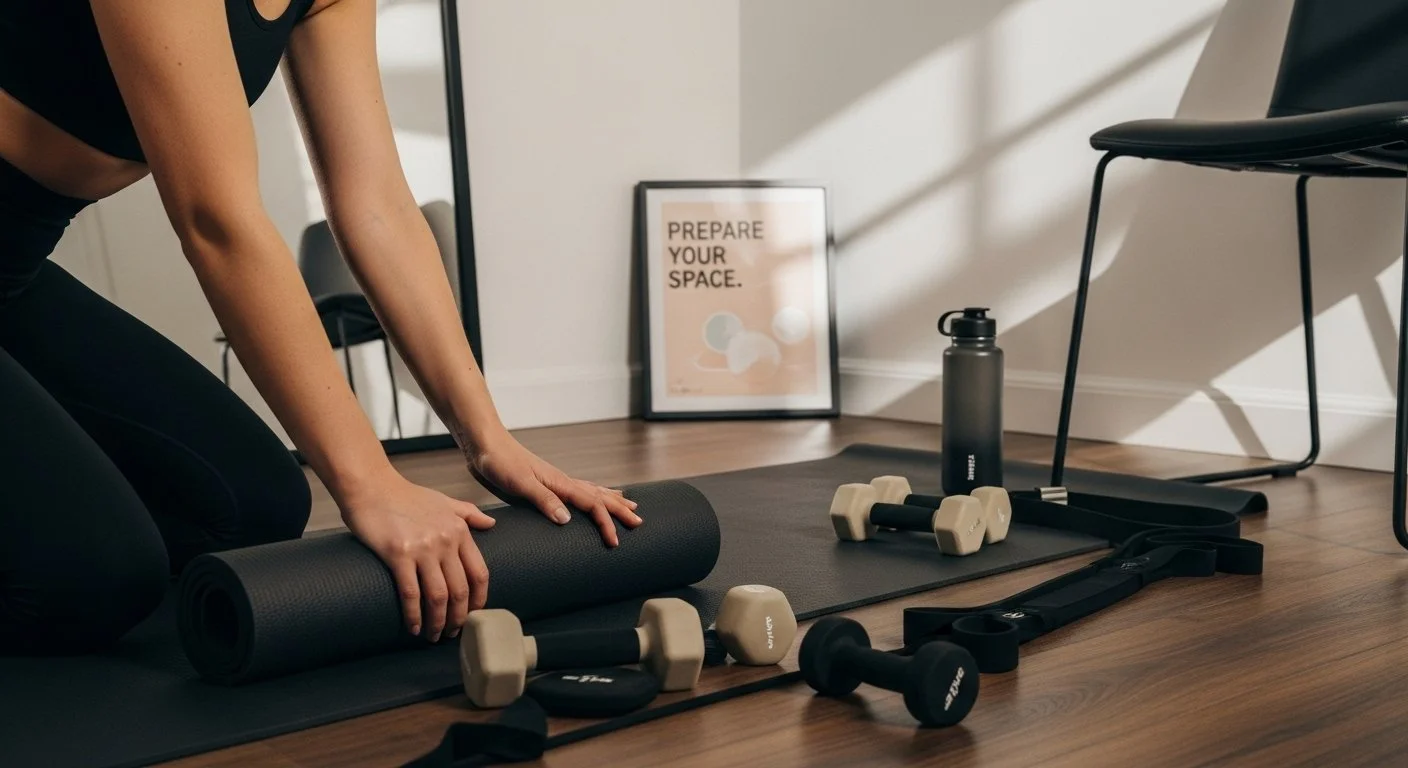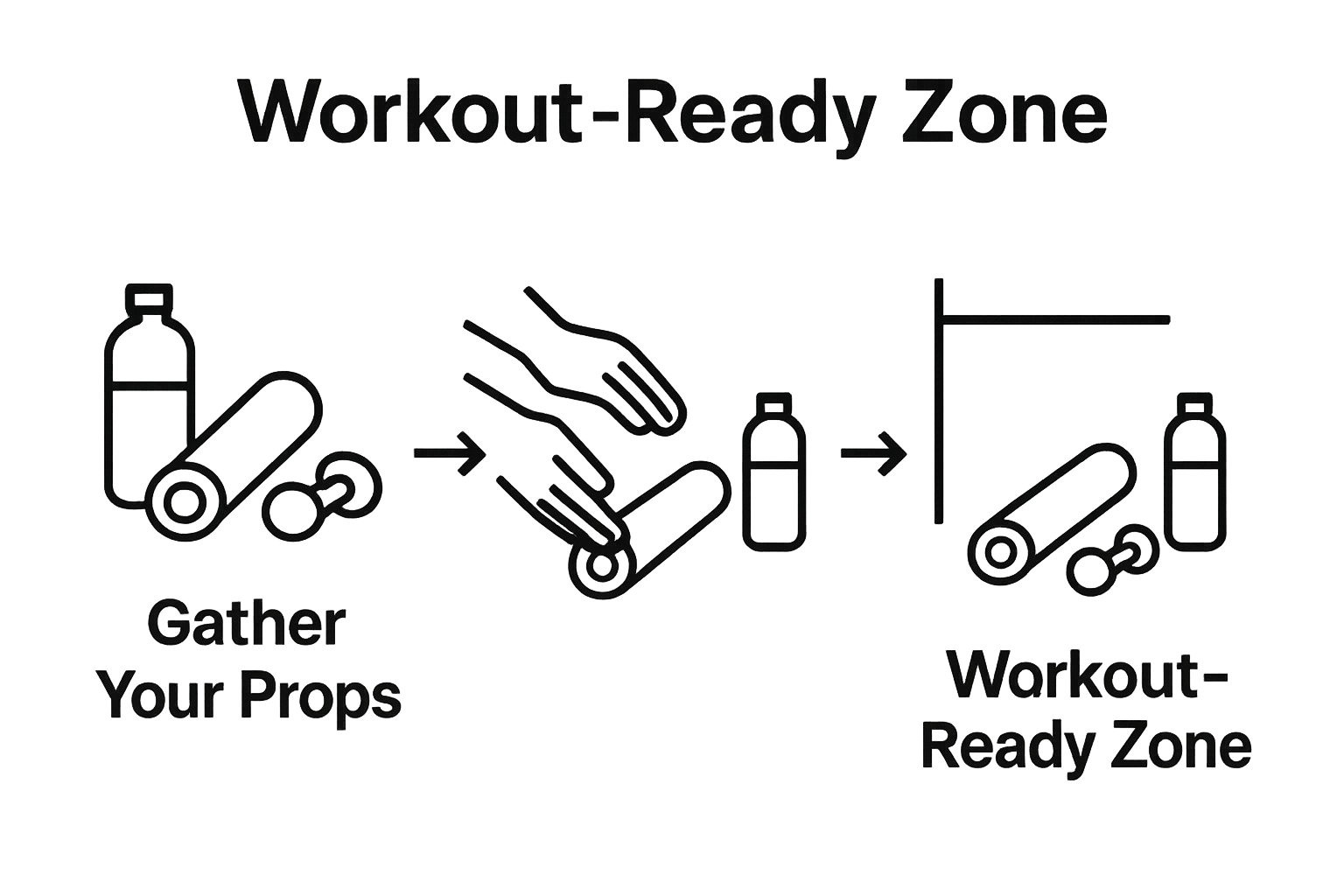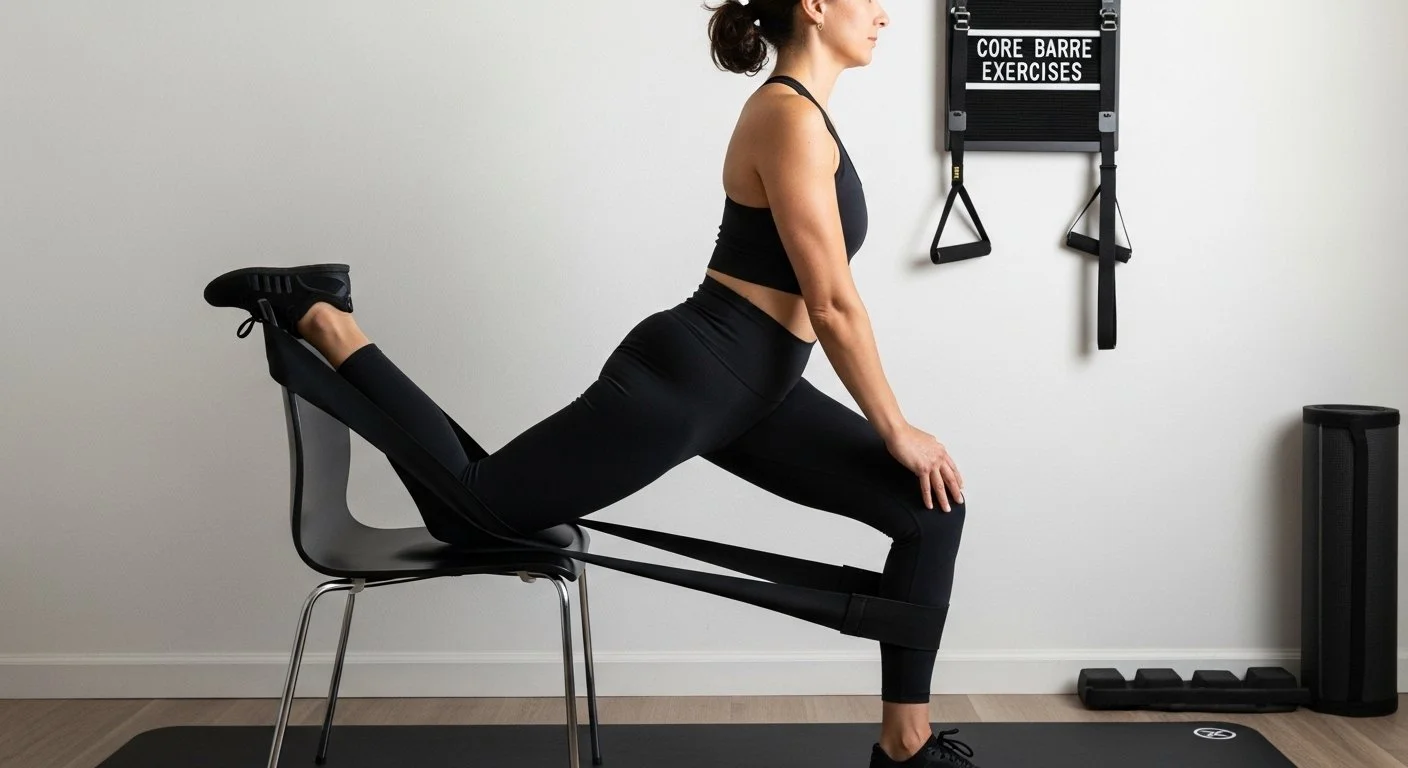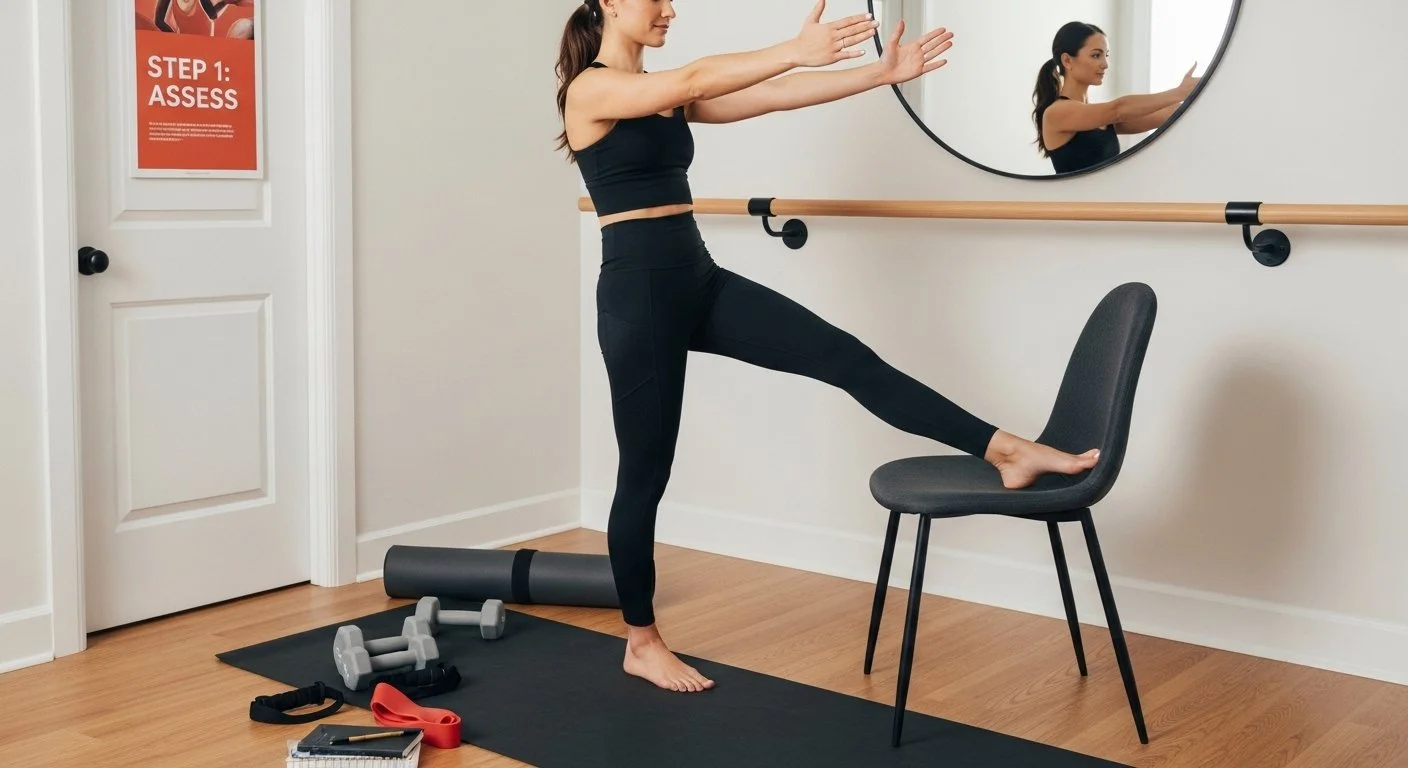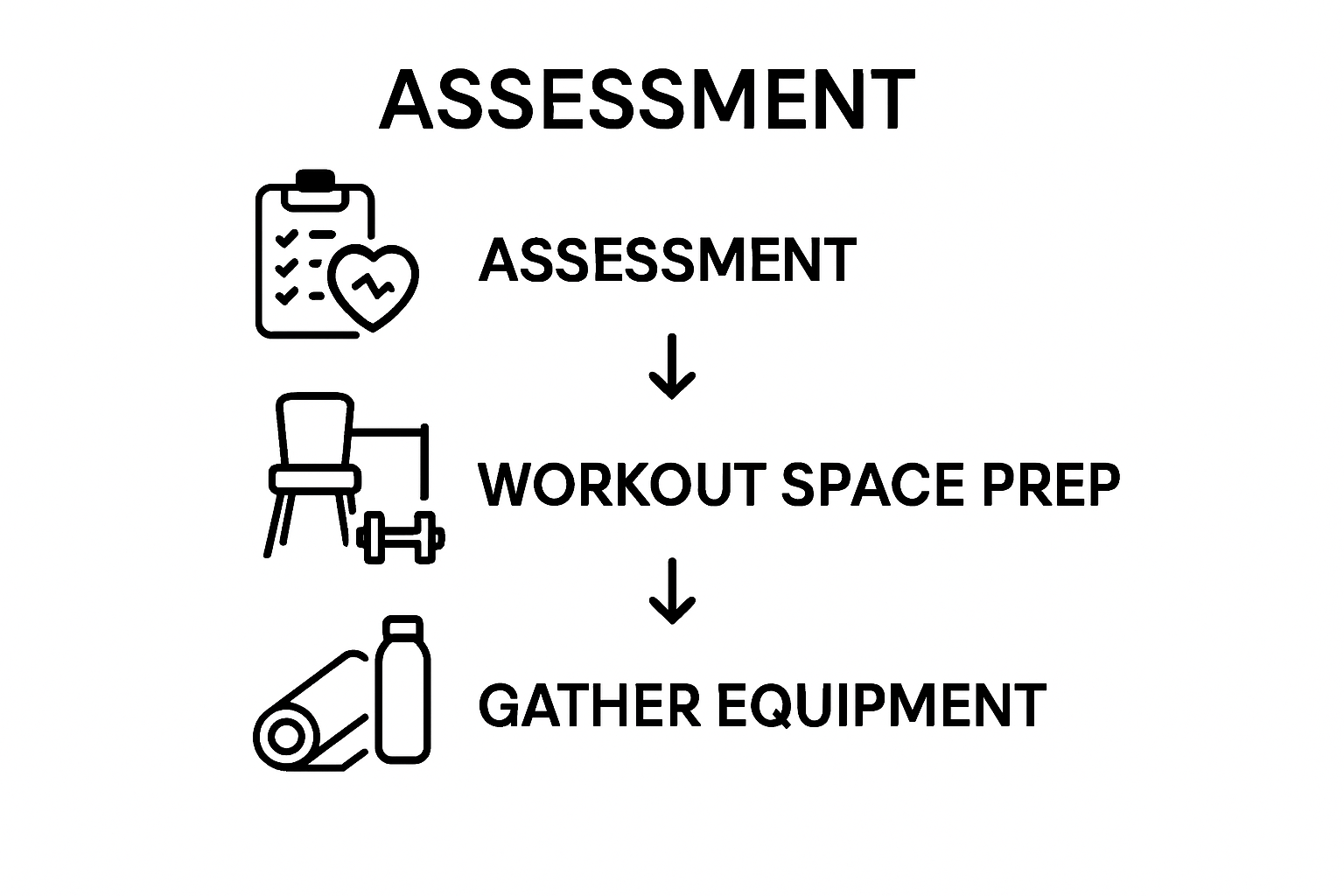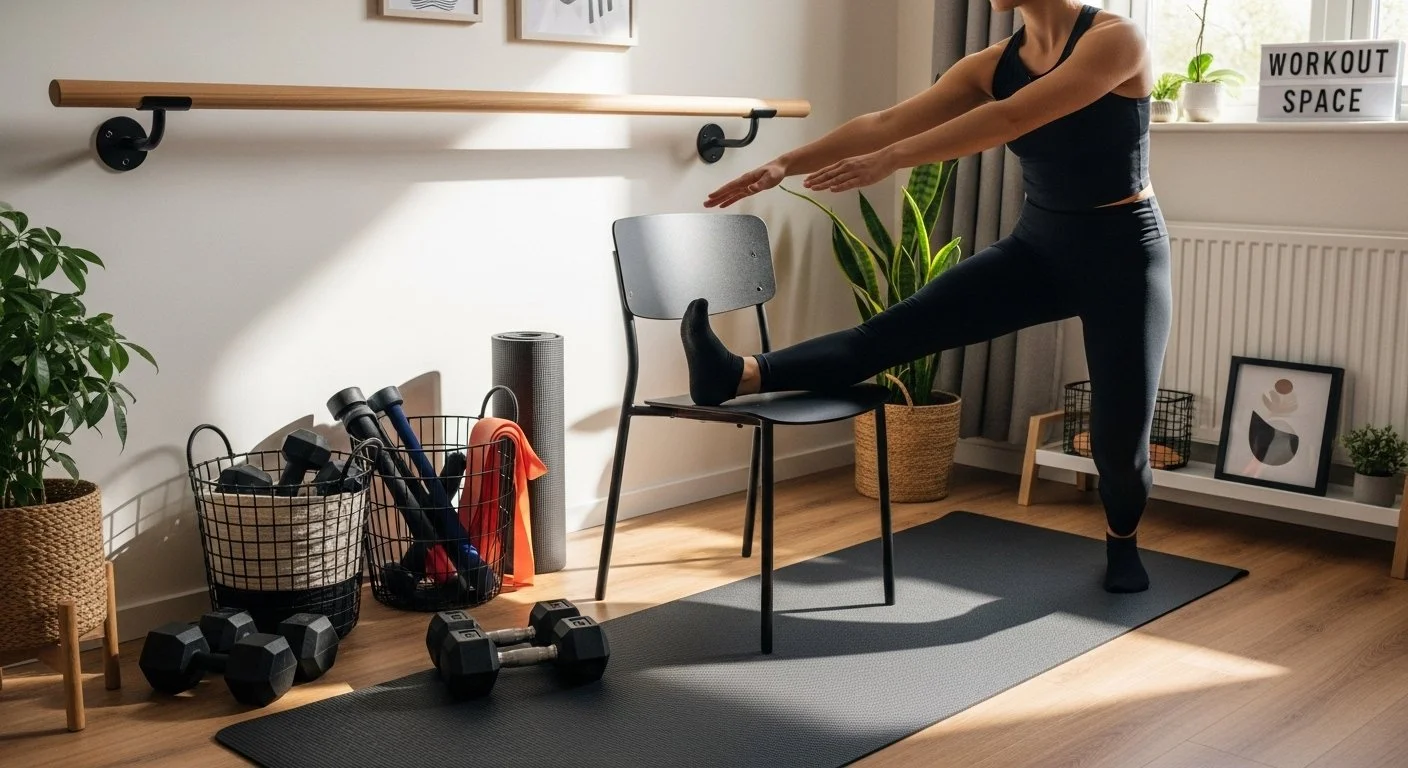Barre Workout Step by Step: Achieve a Stronger Body
Heather Rice
Setting up your home for barre workouts sounds simple. Yet studies show that clearing just 6 square feet of space can make workouts safer and more effective. Most people think the secret to barre is all about fancy moves and special gear, but the real game-changer is how you prepare your space before you even start stretching.
Table of Contents
Quick Summary
Key PointExplanation1. Create an uncluttered workout spaceDesignate at least 6 square feet of clear space to allow free movement during barre exercises.2. Gather essential equipment beforehandCollect items like a mat, light weights, and resistance bands to minimize interruptions during your workout.3. Perform a targeted warm-upEngage in dynamic stretches to increase blood flow and prepare your muscles for barre exercises, enhancing performance and preventing injuries.4. Focus on precision during movementsPay close attention to technique and alignment during barre exercises to maximize effectiveness and reduce injury risk.5. Cool down and reflect post-workoutInclude gentle stretches and self-assessment after workouts to aid recovery and solidify the experience for future improvements.
Prepare Your Space for an Effective Workout
Transforming your home environment into a dedicated barre workout sanctuary requires strategic planning and intentional setup. Before diving into your barre workout step by step, creating a conducive space will significantly enhance your exercise experience and performance. Physical preparation matters as much as mental readiness when establishing an effective home fitness routine.
Choosing the right location is paramount. Select a space with enough room to move freely, ideally near a wall or sturdy piece of furniture you can use for balance and support. Hardwood or smooth flooring works best, but a high-quality yoga mat can also provide the necessary grip and cushioning. Clear at least 6 square feet of unobstructed space to allow full range of movement during your barre exercises.
Essential equipment should be within easy reach before beginning your workout. Consider gathering these key items:
Yoga or exercise mat
Water bottle
Light hand weights (2-3 pounds)
Resistance bands
Towel
Lighting and ventilation play crucial roles in creating an optimal workout environment. Position yourself near natural light if possible, which can boost mood and energy. Ensure the room temperature is comfortable but not overly warm, allowing your body to regulate heat during intense movements. According to fitness experts at ACE Fitness, a well-ventilated space helps maintain proper body temperature and prevents overheating during exercise.
Remove potential tripping hazards like loose rugs, electrical cords, or furniture with sharp edges. Your safety is paramount, and a clutter-free zone will help you focus on executing precise barre movements. Consider using our guide on creating a holistic workout workflow to further optimize your home exercise environment.
Finally, set up a small mirror if possible. While not mandatory, a mirror can help you monitor form and alignment, crucial elements in barre workouts. Position it where you can see your entire body during movements, allowing real-time technique adjustments. With your space meticulously prepared, you are now ready to begin your transformative barre fitness journey.
Here is a quick reference table outlining the main steps of a barre workout, including estimated time and the primary focus of each phase.
StepEstimated TimePrimary FocusPrepare Your Space5 minutesSafety, setup, and mental readinessGather Necessary Props and Equipment3 minutesAccessibility and organizationWarm Up Your Body with Stretches8-10 minutesIncrease blood flow, prevent injuryExecute Core Barre Exercises20-35 minutesPrecision movements, muscle engagementCool Down and Reflect5-7 minutesRecovery, stretching, mindful review
Gather Necessary Props and Equipment
Successful barre workouts depend on having the right equipment to support your fitness journey.
Proper props are not just accessories but essential tools that enhance your workout effectiveness and help prevent potential injuries. Think of these items as strategic investments in your health and fitness progression.
The cornerstone of your barre equipment arsenal is a high-quality exercise mat. Look for a mat with excellent grip and sufficient cushioning to protect your joints during floor work and balance exercises. Thickness matters - aim for a mat between 4-6 millimeters, which provides stability without compromising your connection to the floor. Specialized barre or Pilates mats often feature extra padding and non-slip surfaces ideal for these precise movements.
Light hand weights are another crucial component. Unlike heavy weightlifting equipment, barre workouts typically utilize light weights between 2-5 pounds. These small weights create resistance that challenges muscle groups without overwhelming them. Consider investing in adjustable dumbbells or a compact set of hand weights to provide versatility as your strength increases.
Additional essential equipment includes:
Resistance bands (light to medium tension)
Stability ball (optional but beneficial)
Small hand towel
Water bottle
Grip socks (recommended for better traction)
Research from the American Council on Exercisesuggests that versatile, compact equipment allows for more consistent home workouts. Resistance bands, in particular, offer remarkable flexibility. They can simulate many barre movements while providing adjustable tension that adapts to your fitness level.
Consider your budget and long-term fitness goals when selecting equipment. While professional barre studios might have extensive gear, home practitioners can achieve excellent results with minimal investment. Learn more about creating an effective workout workflow to maximize your equipment usage.
Before starting your workout, verify your equipment checklist. Ensure all items are clean, in good condition, and positioned within easy reach. A well-organized setup reduces interruptions and maintains the flow of your barre routine.
To help you prepare your home setup, here is a table summarizing essential barre equipment, recommended specifications, and their primary purposes.
EquipmentRecommended SpecificationPurposeExercise Mat4-6 mm thick, non-slipProvides cushioning and grip for floor/barre workLight Hand Weights2-5 poundsAdds light resistance for toning and strengthResistance BandsLight to medium tensionOffers adjustable resistance, muscles engagementStability BallOptional, small sizeEnhances balance, core strength (optional)TowelSmall hand towelWipes sweat, aids grip on surfacesWater BottleAny sizeKeeps you hydrated during workoutGrip SocksNon-slip, barre/Pilates styleImproves traction, reduces slipping
Warm Up Your Body with Targeted Stretches
Before diving into the intensity of a barre workout, preparing your body through strategic stretching is crucial for optimal performance and injury prevention. A comprehensive warm-up primes your muscles, increases blood flow, and sets the foundation for a successful exercise session. Think of this phase as a gentle invitation to your body, gradually awakening muscle groups and increasing flexibility.
Begin with gentle full-body movements that progressively increase your heart rate and warm your muscles. Start with light marching in place, swinging your arms naturally and rolling your shoulders to release tension. Move with intentional, controlled motions that feel comfortable and smooth. This initial phase helps transition your body from a resting state to an active workout mode, preparing both physical and mental systems for the upcoming barre routine.
Transition into dynamic stretching, which involves moving parts of your body through a full range of motion. Perform gentle leg swings, alternating forward and side movements to activate hip flexors and improve mobility. Incorporate arm circles, both forward and backward, to warm up shoulder joints and upper body muscle groups. Breathe deeply and maintain a steady, rhythmic pace during these movements, allowing your body to naturally generate internal heat.
Specific warm-up sequences for barre workouts should include:
Ankle rolls and heel lifts
Gentle spine twists
Light squats with arm movements
Standing leg extensions
Torso side bends
According to fitness experts at ACE Fitness, a proper warm-up reduces injury risk and enhances overall workout performance. Pay attention to how your body feels, modifying movements if you experience any discomfort.Listening to your body is keyto a safe and effective warm-up routine.Explore our guide on mindfulness practicesto enhance your body awareness during these preparatory movements. The goal is not just physical preparation but also mental centering. Aim to complete your warm-up in 8-10 minutes, ensuring your muscles are warm, joints are mobile, and your mind is focused and ready for the barre workout ahead.
Execute Core Barre Exercises with Precision
Mastering barre exercises requires understanding the nuanced connection between muscle engagement, body alignment, and controlled movement.
Precision is the hallmark of an effective barre workout, transforming seemingly simple movements into powerful muscle-sculpting techniques. Unlike traditional strength training, barre focuses on small, isometric movements that challenge muscles through sustained tension and strategic positioning.
Begin with foundational plié positions, which serve as the cornerstone of barre technique. Stand alongside a support surface, placing one hand lightly on the barre or chair for balance. Position your feet in a turned-out position, heels together and toes pointing outward at approximately a 45-degree angle. Maintain a straight spine and engage your core, allowing your weight to distribute evenly between both legs. Slowly bend your knees, keeping them aligned with your toes while maintaining an upright torso. The key is controlled descent and ascent, creating continuous muscle tension.
Transition into leg lifts and pulse sequences that target specific muscle groups. These movements involve minimal range of motion but maximum muscle engagement. When performing leg lifts, focus on maintaining a stable upper body while creating precise, controlled movements in your lower body. Keep your standing leg slightly bent to protect your joints and generate continuous muscle activation. Small, rhythmic pulses at the top of the movement intensify muscle work without requiring extensive motion.
Critical elements to remember during barre exercises include:
Maintain consistent breathing
Keep movements small and controlled
Engage core muscles throughout each position
Monitor body alignment
Use support for balance when needed
Research from the American Council on Exercisehighlights the unique muscle-conditioning approach of barre fitness. By emphasizing precise movements and sustained muscle tension, these exercises create long, lean muscle definition different from traditional strength training methods.
Check out our workflow for optimal health to enhance your understanding of movement techniques. Pay close attention to your body's signals, modifying movements as needed while maintaining the fundamental principles of alignment and controlled engagement. Success in barre comes not from how far you move, but from the intentional quality of each microscopic motion.
Cool Down and Reflect on Your Progress
The final phase of your barre workout is more than a physical wind-down - it's a critical moment of mindful recovery and personal assessment. Cooling down represents the bridge between intense physical activity and your body's return to its resting state, allowing for comprehensive muscle recovery and mental integration of your workout experience.
Begin your cool-down with gentle, full-body stretches that target the muscle groups you've just engaged during your barre routine. Start by standing with feet hip-width apart, slowly rolling down your spine vertebra by vertebra until your hands touch the floor or rest on your legs. This deliberate movement helps release tension in your back, hamstrings, and calves. Hold each stretch for 15-20 seconds, breathing deeply and allowing your muscles to soften and lengthen naturally.
As you transition into seated stretches, focus on mindful reflection. Take a few moments to acknowledge the effort you've just invested in your physical wellness. Consider the precision of your movements, the muscle groups you challenged, and how your body felt during different exercises. This mental review is not about judgment, but about developing a deeper understanding of your physical capabilities and potential areas for future growth.
Important cool-down elements to remember:
Hydrate immediately after stretching
Pay attention to any muscle tension or discomfort
Breathe deeply and rhythmically
Avoid sudden movements
Listen to your body's signals
According to Mayo Clinic experts, a proper cool-down helps gradually lower heart rate and prevent potential dizziness or muscle stiffness. Complement your physical stretches with gentle self-massage, using your hands to knead any areas of tension in your legs, arms, and back.
Explore our guide on mindfulness practices to deepen your post-workout reflection. Document your workout experience in a fitness journal, noting the exercises completed, how your body felt, and any insights gained. This practice transforms your barre workout from a mere physical activity into a holistic journey of self-discovery and continuous improvement. Remember, true progress is measured not just in physical changes, but in your commitment to consistent, mindful movement.
Ready to Transform Your Barre Journey With Real Results?
Have you been struggling to create lasting change with home barre workouts? Maybe you have set up your space, gathered equipment, and followed each step, but still feel stuck or unsure about your next move. You are not alone. Many people face the challenge of turning fitness routines into sustainable results and genuine well-being. At Amrita Yoga & Wellness, we align with your goals of cultivating strength, precise movement, and mindful progress. Our expert-led barre classes and holistic wellness services are designed to help you move past obstacles and find the support you need.
Stop settling for inconsistent home routines. Experience the difference of guided classes, supportive community, and personalized feedback at Amrita Yoga & Wellness. Explore our range of options from energizing barre to mindful yoga and Pilates for all experience levels. Ready to take the next step? View our class schedule and sign up today, or deepen your practice with our wellness workshops. Your stronger, healthier body and mind are waiting—join our community now and make your fitness transformation real.
Frequently Asked Questions
What equipment do I need for a barre workout?
To effectively perform barre workouts, you will need a high-quality exercise mat, light hand weights (2-5 pounds), resistance bands, and a towel. Grip socks are also recommended for better traction.
How much space do I need for a barre workout at home?
You should clear at least 6 square feet of unobstructed space to allow for full movement during your barre exercises. Ideally, select an area near a wall or sturdy piece of furniture for balance support.
What are the benefits of warming up before a barre workout?
Warming up enhances blood flow to your muscles, increases flexibility, and reduces the risk of injury. A proper warm-up prepares both your body and mind for the intensity of the workout ahead.
How do I know if I'm performing barre exercises correctly?
Focus on maintaining proper alignment, engaging your core, and executing small, controlled movements. Using a mirror can help you monitor your form, although paying attention to how your body feels is also key for making adjustments.
Recommended
Master Your Barre Workout Workflow for Optimal Health — Amrita Yoga & Wellness
7 Reasons Why Combine Yoga and Pilates for Wellness — Amrita Yoga & Wellness
Understanding What is Aerial Fitness and Its Benefits — Amrita Yoga & Wellness
What is Aerial Pilates? Understanding This Unique Practice — Amrita Yoga & Wellness
